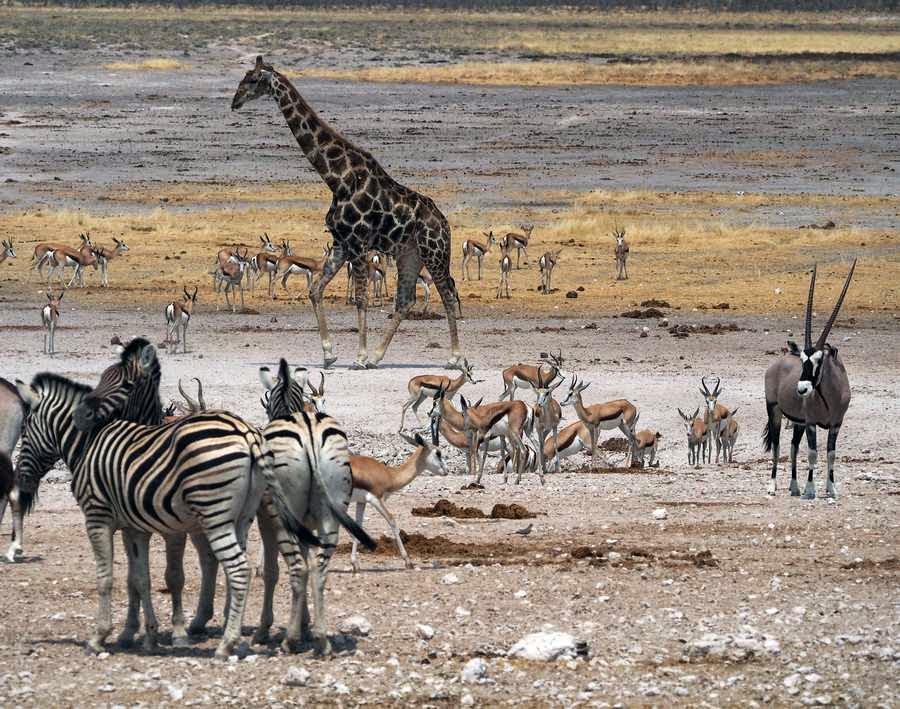In the morning 16th? we went for a game drive. Palmweg Concession is 5,500 sq km and we saw heaps of zebras and springbok and a couple of hyenas. There were guinea fowl, Ruppels Kophaan etc. The dominant vegetation is Euphorbia Damarama which is eaten by kudu, black rhino and steenbok but is very poisonous to humans
That evening at dinner one of the guides told us there was an elephant at the fence very close by so we all trooped out to see it.
17th Sept We left Palmweg at 7 and arrived at Tosharu Lodge just outside Etosha at 6.30 = 800 km drive. Howeve we did make 3 stops - first at Twyfelfontein (Doubtful Spring) where there are thousands of rock engravings done by the Bushman or San people several thousand years ago. On then to the Organ pipes rock formation - think Giant's Causeway. But to get there was about 12 km of horrendous corrugations. The third stop was a petrified forest = pine washed down in a huge flood from Central Africa in the distant past.
Tosharu Lodge was very nice with lots of bougainvillea but the lighting was far too romantic - we could not see a thing. However the buffet dinner was excellent springbok meatballs and kudu stew. As always accompanied by delicious salads and good soup for starters.
18th Sept.
Up at 5.30 and on the road before 7. Etosha was proclaimed a National Park in 1906 and was originally 100,000 sq kms. It is now only one quarter of that size.
Our first sightings were zebras galore and springbok. The zebras in this area are Burchell's and their stripes go right around their bellies.Then we saw 2 white rhino and some impala. Best of all was the Neubroni waterhole with a Noah's ark of animals all drinking. Eventually even the wary giraffe dared to drink.
19th Sept.
Another long days drive to Rundu on the Angolan border. The vegetation is different and since cattle farming has become less profitable the bush is taking over the land.
We stayed at Kaisosi Lodge on the Kaivango River complete with resident peacock.
20th Sept
Today we crossed into Botswana after first paddling through the foot and mouth mat and soaking our spare pair of shoes we carried on into the watery world of the Okovango delta.
A two hour speed boat ride took us to Inkwazi our houseboat home for two nights.
Roadside stall
Dutch Reformed Church
Sunset near the Palmweg lodge
Zebras in the dawn light during our first early morning game drive.
Giraffes do tower over everything else.
A spotted hyena surveys the scene.
Some of the palms which give Palmweg Lodge its name. I think they may be makalini (sp?)
More giraffes posing.
Annalies explaining some of the Bushman rock engravings at Twyfelfontein (doubtful spring).There are thousands of the engravings and they include - rhinos, giraffes, waterholes etc and they date back thousands of years.
Pretty pink flowers at Twyfelfontein. One book called them pink eidelweiss.
The rather comical secretary bird which is about 80 cm tall.
The peculiar Wallachia plant which lives for a hundred years but has only two leaves (I need to check my facts)
The connection has deteriorated so I will be back to finish this post later.
Seems faster now so I will continue.
Donkey cart on the road to Etosha NationalPark.
An iconic tree in Etosha National Park.
White rhino
Wildebeest

Impala
Kori bustard.
Easy to see why kudu were hunted for their antlers.
Social weaver bird nest. They are tiny birds but the community nests are huge
Possibly a white browed sparrow weaver bird
At the Neubroni waterhole in Etosha.
Seems faster now so I will continue.
Donkey cart on the road to Etosha NationalPark.
An iconic tree in Etosha National Park.
White rhino
Wildebeest

Impala
Kori bustard.
Easy to see why kudu were hunted for their antlers.
Social weaver bird nest. They are tiny birds but the community nests are huge
Possibly a white browed sparrow weaver bird
At the Neubroni waterhole in Etosha.
Neubroni waterhole again. It is almost biblical the different species drinking together although the giraffes were very wary.
However the rhino had no trouble keeping his personal space.
The ostriches were a bit feisty.
A lion surveys the waterhole looking for possible dinner.
The ostriches were a bit feisty.
A lion surveys the waterhole looking for possible dinner.
Alfred inspects the truck. We did have a leaking tyre and as each tyre weighs 180 kg that makes life difficult.






























The welwitschia plant does apparently only ever have two leaves according to the Wikipedia article:
ReplyDeletehttp://en.wikipedia.org/wiki/Welwitschia
So maybe they look like there is more because the leaves have shredded over time? Or maybe there are several plants in each clump?